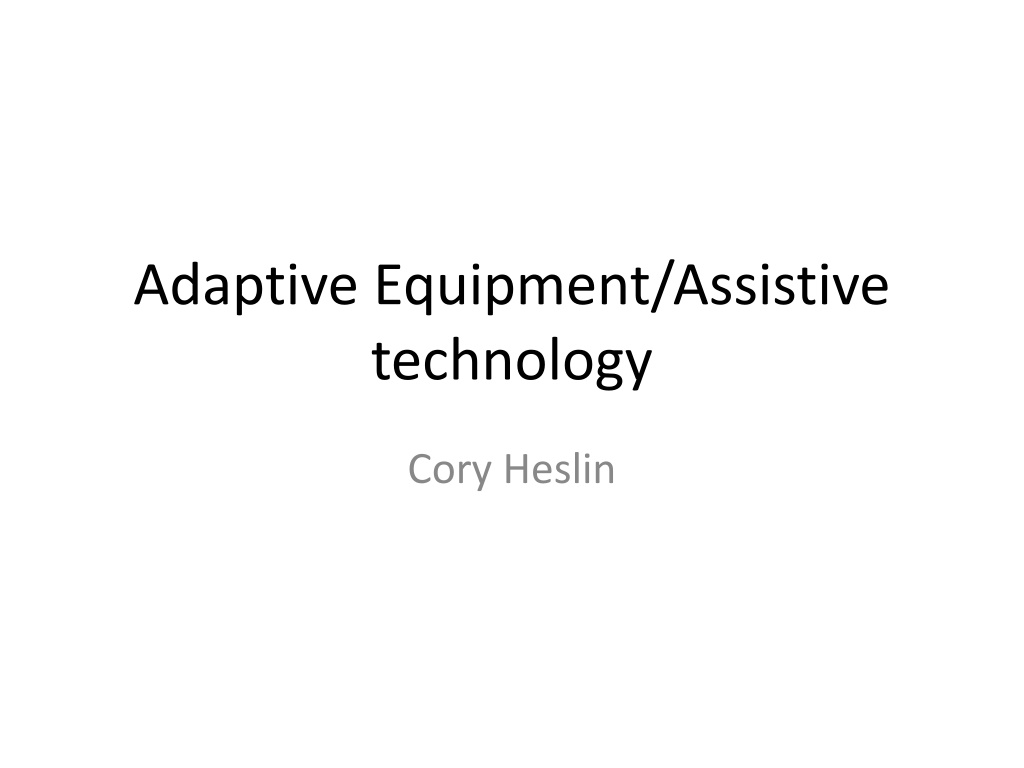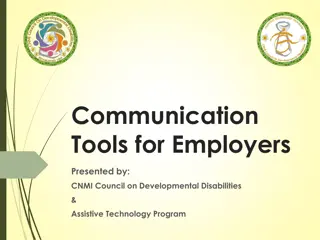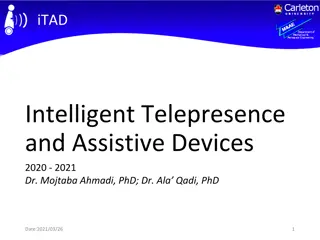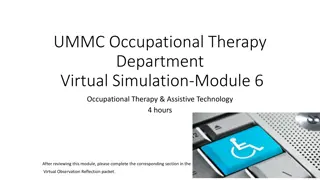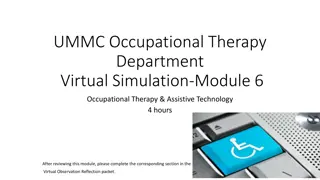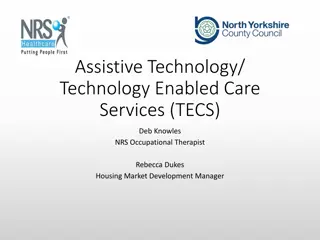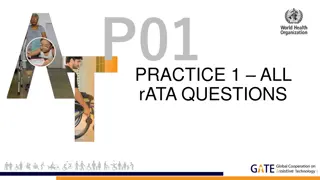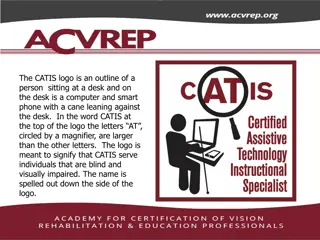Understanding Adaptive Equipment and Assistive Technology for Home Adaptations
Explore the differences between Adaptive Equipment (AE) and Assistive Technology (AT), such as how AE aids in completing functional tasks while AT helps increase independence. Discover examples like Text-to-Speech for dyslexia, Word Prediction for learning disabilities, and Environmental Controls for home automation. Learn about Augmentative Communication Devices and Trackball Mice for those with specific mobility needs.
- Adaptive Equipment
- Assistive Technology
- Home Adaptations
- Augmentative Communication
- Environmental Controls
Download Presentation

Please find below an Image/Link to download the presentation.
The content on the website is provided AS IS for your information and personal use only. It may not be sold, licensed, or shared on other websites without obtaining consent from the author. Download presentation by click this link. If you encounter any issues during the download, it is possible that the publisher has removed the file from their server.
E N D
Presentation Transcript
Adaptive Equipment/Assistive technology Cory Heslin
Adaptive Equipment vs. Assistive technology? What is the difference? AT: broad term that can include any device that helps person to increase independence with a task. AE: assist with completing functional ADL tasks: feeding, grooming, dressing, toileting and self-care skills. Examples of AE: Long-handed shoe horn, sock-aid, shower chair Examples of AT: Environmental controls, text to speech, word prediction
Text to Speech Text to speech: is AE or AT? Assistive technology What is it? Software and apps that allows the use to listen to text already written on the screen. Who could you use it for? College study with dyslexia.
Word Prediction What is word prediction? Software and app that predicts what the use is going to type based on the first few key strokes. What type of people would benefit from this? People with learning disabilities, poor fine motor control Why?
Environmental controls What is environmental controls? Systems that operate the environmental control of a house, using adapted methods. What are some examples of environmental controls you might see in a patient s house? Turn on lights, heat/AC, television, answer the telephone, electronic locks.
Augmentative Communication What is a Augmentative Communication Device? Any device that provides a means of nonverbal communication. This can be low tech or high tech. What is low tech vs. high tech? What are some examples you could use this device for? Individuals that do not have verbal communication. Must have high enough perceptual and cognitive abilities.
Trackball mouse What is the purpose of this? The ball is connected to sensors within the mouse that detects its movement. Thumb/fingers are use to move the cursor on the computer screen. What are some examples you could use this for? Used by people with upper extremity coordination deficits, limited AROM, or UE weakness.
Question A therapist is preparing guidelines for home and environmental adaptations for a patient who has mild dementia. The therapist should first recommend that the family: A.)involve the patient in a variety of stimulating activities B.)assist the patient with all routine care C.)identify familiar objects that the patient can use during daily tasks D.)establish a regular daily routine for the patient with scheduled rest breaks
Question A therapist is instructing a patient who has complete C6 quadriplegia to use a wash mitt and hand-held shower for increased functional independence in bathing. It would be most effective to: A.)use handling techniques to facilitate more normal movement B.)use body positioning for general inhibition C.)incorporate the use of the equipment when practicing bathing D.)increase ROM, endurance, and strength of the upper extremities
Question To achieve independence in oral hygiene, an individual who has complete C6 quadriplegia would most likely benefit from a/an: A.)universal cuff B.)electric toothbrush C.)built-up handle toothbrush D.)long opponens splint
Large key keyboard What is it? A keyboard with enlarged keys, sometimes color coded. What are some examples that you could it for? Coordination deficits Improves visibility for people with low vision
Ergonomic keyboard What is it? Keyboard that is curved to position the wrist and hands in neutral positions during typing tasks. What are some examples you could use this? Used by people who type extensively to prevent repetition motion deficits.
Joystick mouse What is it? Mouse that uses a joystick instead of a cursor. The device can be operated by hand or mouth. What are some examples? Used by people with severe upper extremity coordination deficits or sever UE weakness. Upper extremity paralysis.
Question A patient recovering from an acute myocardial infarction is referred to a therapist for an ADL evaluation. During the evaluation, the patient fatigues quickly and develops shortness of breath. The therapist initial goal of treatment should be to facilitate the patient's: A.) ability to make appropriate activity choices B.)home environment adaptation needs C.)functional capacity for activities D.)speed and efficiency in performing dressing tasks
Question A patient who has right hemiparesis is being discharged home from a rehabilitation unit in one week. The patient completes self-care and mobility activities from a manual wheelchair. The bathroom safety equipment for this patient to use to get in and out of the bathtub would be a: A.)transfer tub bench B.)shower chair C.)grab bar D.)transfer board
Question A therapist completes a work site evaluation for a secretary who has developed bilateral carpal tunnel syndrome. The therapist notes that the secretary s work area has poor ergonomic design. To reduce the risk factor associated with the patient's symptoms, the therapist should recommend: semi flexible splints to reduce abnormal wrist postures using a chair with arm rests so that arms are supported adjusting the computer table height so that the elbows are flexed at 45 degrees placing the computer keyboard in a position so that wrists are neutral
Weighted utensils Spoons, forks, and knives with large handles that have weights inside Weight utensils help increase proprioceptive input. In turn, this helps reduce tremors and improve fine motor control.
Angled utensils Spoons/forks constructed with an angle that bends to bowl. Typical angle is 45 or 90 degrees People with limited UE ROM. Especially those who limited supination.
Swivel utensils Spoons/forks constructed with a larger or built-up handle that contains a swivel point in the end close to the bowl. The spoon swivels to keep the utensils level to prevent spills. Could be used for those who have Parkinson's, tremors and weak grip strength.
Coated spoon Spoon that have a vinyl coating over the bowl. Coated spoons are used with people, especially kids who have oral hypersensitivity.
Rocker Knife A sharp knife that has a curved blade. The handle may be similar to a table knife or maybe T-shaped Rocker knives are used by people with hand weakness, arthritic deformities, and people who have use of one hand.
Universal Cuff Leather pocket that fits within the palm of the hand. The pocket is attached to a velcro closure strap. Universal cuffs are used by individuals who have limited hand function. SCI, TBI, CVA, MS.
Question A patient who had a CVA has fair dynamic sitting balance, but is unable to complete bathtub transfers safely without assistance. The therapist should recommend this patient use a: A.)bathtub board B.)wheeled shower-commode chair C.)transfer tub bench D.)commode placed inside the bathtub
Question A patient who has multiple sclerosis eats independently using large-handled utensils. Recently the patient has required longer rest periods during meals and has spilled food. The therapist should recommend using a: A.)dorsal cock-up splint B.)universal cuff C.)mobile arm support D.)weighted wrist cuff
Question The parent of a 4-year-old child who has a disability explains to a therapist that it is difficult for the child to leave home because of sitting instability on standard-size toilets. The best adaptation would be for the child to: A.)wear diapers on outings B.)use a portable reducer ring on the toilet C.)use an elevated toilet seat D.)decrease liquid intake before outings
Question Seven weeks after total hip replacement surgery due to osteoarthritis, a patient who is employed as a data entry clerk receives a medical release to return to work. The patient's job performance would be most improved with a work area that is equipped with a/an: A.)chair with armrests B.)ergonomic keyboard C.)footstool D.)adjustable-height seat
Question A therapist is treating a 6-year-old child who has spastic cerebral palsy and who exhibits an extensor thrust problem. The most beneficial positioning modification to promote proper sitting and alignment in a wheelchair would be: A.)replacing shoulder straps with a four-point chest harness B.)decreasing the angle of the seat to the back of the chair C.)placing blocks and straps on the foot rests D.)adding abductor pommel and pads to the seat of the chair
